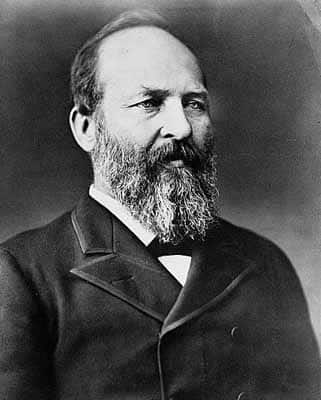James A. Garfield was born in Cuyahoga County, Ohio, in 1831. His father died in 1833, when Garfield was only two years old and so his mother had to carry on working the family farm by herself. With the death of his father, the family feel into poverty. Even though they had very little money, his mother made sure that her children went to the neighborhood school to get a good education. He belonged to the Disciples of Christ Church. While growing up, James drove canal boat teams, and earned enough money to further his education at college. He attended Western Reserve Eclectic Institute at Hiram, Ohio, and was graduated from Williams College in 1856. He returned to Western Eclectic Institute and became a classics professor. Later, he became the president of the College.
In 1858, he was married to Lucretia Rudolph and had seven kids. Eliza, Harry, James, Mary, Irvin, Abram, and Edward. James Garfield was an  advocate for free-soil principles and soon became a supporter of the newly organized Republican Party. And in 1859, he was elected to the Ohio Legislature. During the succession crisis, he advocated coercing the seceding states back into the Union. During the Civil War, he helped to recruit the 42nd Ohio Volunteer Infantry and became the infantry’s colonel. He fought at Shiloh in April 1862, served as a chief of staff in the Army of the Cumberland, saw action at Chickamauga in September of 1863. When the Union victories had been few in 1862, he successfully led a brigade at Middle Creek, Kentucky, against Confederate troops. And in 1862, at the age of 31, he became brigadier general, only to be made a major general in 1863. Meanwhile, in 1862, he was elected by fellow Ohioans to The United States House of Representatives. He was persuaded by President Lincoln to resign his army job and remain in Congress. Said Lincoln, “It is easier to find major generals than to obtain effective Republicans for Congress.” Garfield held his House seat for 18 years by winning repeated elections and became the leading Republican in the House. As Chairman of the House committee on Appropriations, he became an expert on fiscal matters. He also advocated a high protective tariff, and sought a firm policy of Reconstruction for the South. In 1880, he was elected to the United States Senate. At the Republican Convention in 1880, he failed to win the Presidential nomination for his friend, John Sherman, but became the “dark horse” nominee on the 36th ballot.
advocate for free-soil principles and soon became a supporter of the newly organized Republican Party. And in 1859, he was elected to the Ohio Legislature. During the succession crisis, he advocated coercing the seceding states back into the Union. During the Civil War, he helped to recruit the 42nd Ohio Volunteer Infantry and became the infantry’s colonel. He fought at Shiloh in April 1862, served as a chief of staff in the Army of the Cumberland, saw action at Chickamauga in September of 1863. When the Union victories had been few in 1862, he successfully led a brigade at Middle Creek, Kentucky, against Confederate troops. And in 1862, at the age of 31, he became brigadier general, only to be made a major general in 1863. Meanwhile, in 1862, he was elected by fellow Ohioans to The United States House of Representatives. He was persuaded by President Lincoln to resign his army job and remain in Congress. Said Lincoln, “It is easier to find major generals than to obtain effective Republicans for Congress.” Garfield held his House seat for 18 years by winning repeated elections and became the leading Republican in the House. As Chairman of the House committee on Appropriations, he became an expert on fiscal matters. He also advocated a high protective tariff, and sought a firm policy of Reconstruction for the South. In 1880, he was elected to the United States Senate. At the Republican Convention in 1880, he failed to win the Presidential nomination for his friend, John Sherman, but became the “dark horse” nominee on the 36th ballot.
In November 1880, he became the 20th President, winning with a 10,000 vote margin over the Democratic challenger, General Winfield Scott Hancock. As president, he strengthened Federal authority over the New York Customs House, the stronghold of Senator Conkling. He named Conkling’s arch-rival, William H. Robertson, to run the Customs House. This ruling was contested, but Garfield would not back down. “This will settle the question whether the President is registering clerk of the Senate or the Executive of the United States.” Garfield’s presidential career came to an abrupt end on July 2, 1881, in a Washington railroad station when he was shot by Charles Guiteau, only four months into Garfield’s presidency. For eighty days the president lay ill and performed only one official act, the signing of an extradition paper. Alexander Graham Bell tried to find the bullet in Garfield’s body with a metal detector, but was unsuccessful at locating it, because Garfield was laying on a mattress with metal springs. He was taken to New Jersey and seemed to be recuperating but died on September 19, 1881 from an infection and internal hemorrhage.
